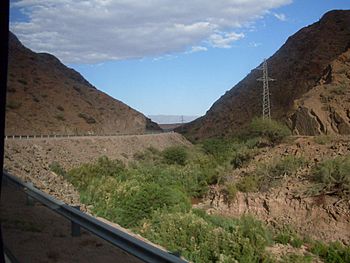Abaucán River facts for kids
Quick facts for kids Abaucán |
|
|---|---|
 |
|
| Country | Argentina |
| Physical characteristics | |
| Main source | Andes |
| River mouth | Desagües del Río Salado |
| Basin features | |
| Basin size | 43,386 km2 (16,751 sq mi) |
The Abaucán River is an important river in Argentina. It flows through two provinces, Catamarca and La Rioja. These areas don't get much rain, so the river's water is very important. It gets its water from two main rivers, the Fiambalá and the Chaschuil.
Contents
The River's Journey
The Abaucán River starts in the northern part of Tinogasta Department in Catamarca Province. It forms from several smaller rivers. These rivers are fed by melting snow and rain from high up in the Andes mountains. Some of these tall peaks include the Nevado Incahuasi volcano, which is 6,638 metres (21,778 ft) high. Other peaks are Cerro El Muerto at 6,488 metres (21,286 ft) and Negro of Laguna Verde at 5,764 metres (18,911 ft).
Different Names for the River
At first, the river is called the Río Chascuil. Then, it joins with another stream from Cerro Cenizo (5,227 metres (17,149 ft) high). After this, it becomes the Río Guanchín. This name continues until it reaches the spa town of Fiambalá, known for its hot springs.
In Fiambalá, the river meets the Río Fiambalá. This river flows from the north and drains very dry areas. After this meeting, the river finally takes the name Río Abaucán. It then flows towards the south-east.
Flowing Through Towns
The Abaucán River passes near the town of Tinogasta. In this area, it forms the southern border of the Salar of Pipanaco basin. A salar is a large salt flat. Sometimes, the river and the salt flat can exchange water.
From this point, the river is also known by other names. People might call it the Río Salado, Colorado, or Bermejo. It then flows into the province of La Rioja.
The River's End
After leaving the Pipanaco basin, the river flows between two mountain ranges. These are the Sierra of Ambato and the Sierra of Velasco. A little later, the river ends its journey. It disappears into a salty semi-desert area called Desagües del Río Salado.
Water Flow and Importance
Even though the Abaucán River has a large basin, its water flow is quite small. Measurements from the 20th century show this. In Tinogasta, the river's average flow was about 2.54 cubic metres per second (90 cu ft/s). The highest daily flow recorded was 85 cubic metres per second (3,000 cu ft/s).
At Tinogasta, the river's basin covers about 28,300 square kilometres (10,900 sq mi). This is roughly the size of Belgium. The Tinogasta area is like an oasis. It gets plenty of water from the Abaucán River and underground water sources. This area is famous for its vineyards, which need a lot of water.
Why the Flow Decreases
Below Tinogasta, the river's flow steadily gets smaller. It doesn't receive much more water from other streams. Instead, it loses water in two main ways. First, water soaks into the sandy ground, which is very permeable. Second, water evaporates because of the high temperatures in the plains. Even with these losses, the river usually provides enough water for the small towns along its path.
River and Salt Flats
In some parts, the river's bed is at the same level as the salar (salt flat) of Pipanaco. If the water levels in the salt flat rise a lot, the salt flat can overflow. This extra water can flow into the Abaucán River. This makes the river's water much saltier. The opposite can also happen, where the river's water flows into the salt flat.
Route National 60
A major road, Route National 60, follows the Abaucán River for almost its entire length. This road connects Córdoba to Chile. It crosses the Andes through the Paso de San Francisco, which is 4,748 metres (15,577 ft) high.
How the River Gets Water
The Abaucán River is a "nival" river. This means its water comes mainly from melting snow in the high Andes mountains. The river's entire basin covers an area of 43,386 square kilometres (16,751 sq mi). This is a bit larger than the country of Switzerland.
See also
 In Spanish: Río Abaucán para niños
In Spanish: Río Abaucán para niños

